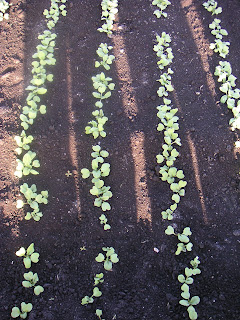 The first time I saw the muck soils of south Florida, I thought I was back in the Midwest. Before my eyes stretched thousands of acres of soil, black as night. The soil got me excited, because it so resembled the black loam of my home state. I was disappointed however, when I got into the field and reached down to take a handful of dirt. It was not cool and moist like I suspected, but brittle and dry.
The first time I saw the muck soils of south Florida, I thought I was back in the Midwest. Before my eyes stretched thousands of acres of soil, black as night. The soil got me excited, because it so resembled the black loam of my home state. I was disappointed however, when I got into the field and reached down to take a handful of dirt. It was not cool and moist like I suspected, but brittle and dry. There are approximately 40,000 acres of muck soil in the Everglades area, and it has been farmed since the early 1900's. To the right is a postcard from 1920 showing fields of muck soil (from the J.S. Wooley photograph collection, University of Miami Libraries, Copyright 2006). The muck soil came from decomposing sawgrass that was exposed when the Everglades were drained. Composed of almost entirely organic matter, it is very rich, and capable of large yields. When you visit vegetable fields in the Everglades (around Belle Glade, for example), you see large-scale agricultural operations that blow your mind.
There are approximately 40,000 acres of muck soil in the Everglades area, and it has been farmed since the early 1900's. To the right is a postcard from 1920 showing fields of muck soil (from the J.S. Wooley photograph collection, University of Miami Libraries, Copyright 2006). The muck soil came from decomposing sawgrass that was exposed when the Everglades were drained. Composed of almost entirely organic matter, it is very rich, and capable of large yields. When you visit vegetable fields in the Everglades (around Belle Glade, for example), you see large-scale agricultural operations that blow your mind. Thousands of acres of spinach, for example, with perfectly straight rows that stretch right to the horizon. I am used to large corn and soybean fields in the Midwest, which stretch along rolling hills, and are broken up by country roads, windbreaks, and wooded streams. The fields in the Everglades seem vast in comparison, with nothing to break them up besides the occasional irrigation canal.
Thousands of acres of spinach, for example, with perfectly straight rows that stretch right to the horizon. I am used to large corn and soybean fields in the Midwest, which stretch along rolling hills, and are broken up by country roads, windbreaks, and wooded streams. The fields in the Everglades seem vast in comparison, with nothing to break them up besides the occasional irrigation canal.
Sadly, the muck soils are not built to last. The soil is continually lost by contact with air, through an oxidation of the organic matter. They are also prone to being carried away by wind, resulting in large tornado-like swells of soil, called "dust devils". Already in some fields the muck soil is so shallow that the underlying rock is exposed when the fields are tilled. At the University of Florida Everglades Research and Education Center in Belle Glade, there is a concrete post which was driven down flush with the soil line in the 1924. Now it sits above ground about 6 feet, quite a bit of soil to lose in 80 years! (See a photo of it below.)

What will become of the muck soil land when it can no longer be farmed? Ideally it could be turned into Everglades restoration land. But I fear that much of it could be turned over to development, increasing the urban jungle that has laid claim to south Florida.
For more information on muck soil subsidence and future use of muck soil land, read this 2004 report from UF EREC.




Hello,
ReplyDeleteMiami city tour
This was a great blog with awesome information. Which contains real facts of the topic miami city tour.
Thank you!
Hi, I loved your blog style & also your contribution that you provide
ReplyDeleteus.Miami Citythe colorful and magical city.you will see how its skyline is as beautiful as its palm-lined beaches, catch a glimpse of Miami attractions.